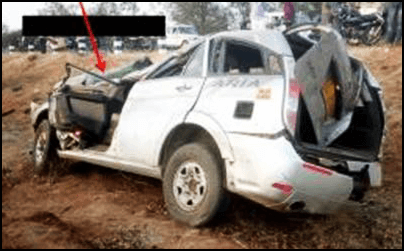-
What happened?
A driver worked for 8 hours (full shift), took 4 hours break, and started a new shift.
He drove from location A to location B for 3 hours. On the return route, the car exited the paved road and rolled over.
The driver’s injuries were fatal.

-
Why did it happen?
Lack of fatigue prevention measures.
The major risk that caused this accident was fatigue due to insufficient recovery time between shifts.

-
What did they learn?
In case of self-driving, account for working and travelling hours, not only driving hours.
The additional risk caused by different driving cultures and different legal requirements should be assessed and managed.
Visually inspect the vehicle before every use.
All drivers and passengers should wear the seat belt.
All heavy and hard items should be stored in the boot.
Ensure that:
- drivers/driving service companies are selected considering HS&E criteria as veto criteria.
- drivers are physically and mentally healthy and fit to drive safely.
- drivers demonstrate careful and non-aggressive driving attitudes. A few examples of veto criteria: exceeding speed limits, driving too fast into curves or over hills with limited visibility of potential obstructions on the route, diverting in the latest moment before crash on one-way routes.
The vehicle should be chosen based on reliability, safety, and environmental criteria.
The European NCAP crash test and the United States IIHS-HLDI crash test provide information for the selection of safe vehicles.

-
Ask yourself or your crew
How can we ensure that:
- we are healthy and fit to drive in case we are self-driving?
- our drivers are healthy and fit to drive safely?
What should you do if you are feeling tired while driving?
How do you assess and manage different driving cultures and different legal requirements?
What measures for safe driving do we have on our site/global business? How can we improve?

Add to homescreen
Content name
Select existing category:
Content name
New collection
Edit collection
What happened?
A driver worked for 8 hours (full shift), took 4 hours break, and started a new shift.
He drove from location A to location B for 3 hours. On the return route, the car exited the paved road and rolled over.
The driver’s injuries were fatal.

Why did it happen?
Lack of fatigue prevention measures.
The major risk that caused this accident was fatigue due to insufficient recovery time between shifts.
What did they learn?
In case of self-driving, account for working and travelling hours, not only driving hours.
The additional risk caused by different driving cultures and different legal requirements should be assessed and managed.
Visually inspect the vehicle before every use.
All drivers and passengers should wear the seat belt.
All heavy and hard items should be stored in the boot.
Ensure that:
- drivers/driving service companies are selected considering HS&E criteria as veto criteria.
- drivers are physically and mentally healthy and fit to drive safely.
- drivers demonstrate careful and non-aggressive driving attitudes. A few examples of veto criteria: exceeding speed limits, driving too fast into curves or over hills with limited visibility of potential obstructions on the route, diverting in the latest moment before crash on one-way routes.
The vehicle should be chosen based on reliability, safety, and environmental criteria.
The European NCAP crash test and the United States IIHS-HLDI crash test provide information for the selection of safe vehicles.
Ask yourself or your crew
How can we ensure that:
- we are healthy and fit to drive in case we are self-driving?
- our drivers are healthy and fit to drive safely?
What should you do if you are feeling tired while driving?
How do you assess and manage different driving cultures and different legal requirements?
What measures for safe driving do we have on our site/global business? How can we improve?
A driver worked for 8 hours (full shift), took 4 hours break, and started a new shift. He drove from location A to location B for 3 hours. On the return route, the car exited the paved road and rolled over. The driver’s injuries were fatal.









